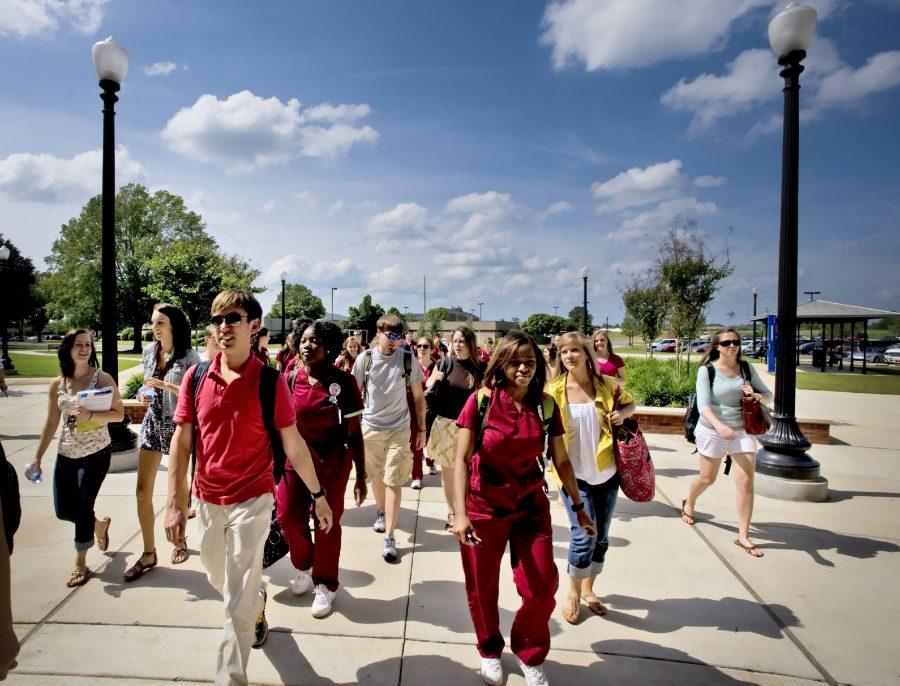“Nursing education has evolved in many ways over the past twenty years,” said Suzanne Prevost, dean and professor of the Capstone College of Nursing. “The increased use of technology is one of the more visible changes. Nurses need a strong knowledge base in information technology and the mechanical aptitude to effectively manage the wide variety of diagnostic tools, monitors and interventional equipment used in health care facilities.”
“It used to be that you were limited by your geographical location to get particularly advanced degrees, but now because of online courses, which may require students to come to campus a few times during their program, it has allowed nursing education to be available for everyone,” said Susan Appel, a professor in the Capstone College of Nursing.
Technology is a big factor that changes constantly in all fields, but not everyone would expect the changes the nursing field has recently been through. Entirely different philosophies in teaching have been adopted that feature simulations and hands on situational-based learning with a strong emphasis on critical thinking.
“It is not sufficient for nurses and nursing students to just read and memorize course content. They must know how to use that information to solve clinical problems, sometimes in life and death situations,” Prevost said. “Because of this need for nurses to be prepared to think on their feet, our instructional approaches and our methods of testing have evolved to be very action-oriented rather than the traditional sage on the stage approach.”
These changes in the nursing field require educators to put them into action and create capable nurses that can be relied upon under any circumstance.
In order to encourage more nursing students to pursue doctoral degrees and take on teaching careers, UA is using money from a recent grant to offer loans to the students at a reduced interest rate, with potential for loan forgiveness of up to 85 percent. The grant, which the University received from the United States Heath Resources and Services Administration, Bureau of Health Professions Division of Nursing, was first given to UA last year for the amount of $133,316, which helped support 14 students. This year, the University was given $263,890, which will be used to continue the support of the original 14 students, as well as offer loans to new borrowers.
Appel said the loans that come out of the recent grant will help enrollment.
“That [the loan] is going to encourage more nurses to go into education, which is a big gap, and there is a lack of people with advanced degrees like a Ph.D. That will help meet those needs,” Appel said.
Unlike other common student loans, such as federal loans students receive through their FAFSA, this money grant is not given out based on need.
“The loans are not awarded due to significant financial needs; therefore almost all Ed.D. students will qualify for some amount of funding on a first come, first serve basis,” said Alice March, assistant dean for graduate programs and an associate professor of nursing.
A large incentive for accepting the loans is that students will not have to pay back the majority of the money if they follow through with a specific post-graduation service agreement.
“Each borrower must complete four years as a full-time nurse educator at an accredited nursing program,” March said. “For each of the first 3 years, there is a 20 percent principal and interest forgiveness. Upon completion of the fourth year, an additional 25 percent of principal and interest are forgiven; thus totaling 85 percent in all.”
The student then would be required to pay the remaining 15 percent of the money they borrowed back at a reduced interest rate.
“The current interest rate for this loan is 3 percent as long as the borrower completes the program and does not default on the service agreement,” March said.
March said one of the main demographics of borrowers for this loan is professionals in the nursing field looking to go back to school.
“Because the nursing profession needs new nurse educators to take care of all of the students that really are coming through here, we want to encourage them [nurses and teachers] to come back to school,” March said. “The current faculty is aging. The average age of a nurse educator is about 55-57 right now, so you can imagine that there will be retirement coming up.”
Donna Lemkin, a nurse working at the DCH Regional Medical Center, said she would have considered the loan offer before she became a nurse, had her life-circumstances been different.
“Pre-children? Absolutely. Currently in my life? Not even if you gave me the whole loan,” Lemkin said.
Lemkin began working as a nurse after obtaining her two-year degree from Jefferson Davis College in Brewton, Alabama. She started a bachelor’s program, but pregnancy prevented her from completing the degree. She has been working as a nurse for 24 years, and said she would consider a loan option later in life, but as for right now, her children’s schooling takes precedence over her own.
“I have children in college now, so I can’t stop working and go to school right now myself,” Lemkin said. “Maybe one day I might would consider it, but currently, I am extremely fulfilled at the bedside.
“I wish I could see more people go into nursing,” she said. “Not because it is a good paying job, but because they want to make a difference in people’s lives. It’s a very rewarding job for me. If I have to be away from my family, I feel like I can make a difference, and I very much enjoy what I do.”









